Composition and Dynamics of the Sonosphere Along a Soil-Surface Ecotone at an Agricultural Site in Northern Italy: A Preliminary Approach
Abstract
1. Introduction
- Test the efficiency of probes in capturing sounds from both below ground (soilscape) and above ground (landscape) simultaneously, based on the geo-morphological configurations of the sample points.
- Explore how Sonic Heterogeneity Indices (SHIs) [34] and their derivative indices can help uncover sonic patterns within the sonosphere while simultaneously describing and interpreting below-ground and above-ground sonic dynamics.
2. Materials and Methods
2.1. Study Area
Farming Activity
2.2. Site Selection
- (1)
- Ground slope—sloped or flat.
- (2)
- Landcover—bare soil (after recent plowing), dry meadow, wet meadow, edge (between a grove and a grass cover), grassy sloping ground, and lawn.
- (3)
- Tree cover—the presence or absence of trees.
- (4)
- Soil disturbance—estimated time interval from the last plowing event (never, far > 1 year, and recent < 1 year).
- (5)
- Vegetation and soil management—mowed, shredded, brushed, or plowed.
- (6)
- Organic matter—soil color estimation of organic content: brown (rich) or yellow ochre (poor). We classified organic matter into “rich”, “moderately rich”, and “poor”. The brown-colored soil has an average depth of 50–60 cm and is rich in organic matter. The yellow ochre soil, probably excluded by the past intense cultivation, has an average depth of 100 cm and is composed of a yellow ochre sand–clay matrix in which boulders were eliminated by repeated plowing. The yellow ochre soil is locally called “chestnut soil” because it is probably more adapted to growing chestnut trees.
2.3. Environmental Variables
2.4. Sound Sampling
2.5. Data Processing and Ecoacoustic Indices
3. Results
3.1. Data Capacity and Processing
3.2. Environmental Features
3.3. Sonic Sources
3.4. Spectral Sonic Signatures
3.4.1. Spectral Sonic Signature (SSS)
3.4.2. Temporal Sonic Signature (TTS)
3.4.3. Spectral Sonic Variability (SSV) and Effective Number of Frequency Bins (ENFB)
3.4.4. Temporal and Spectral Sonic Dissimilarity
4. Discussion
5. Conclusions
Supplementary Materials
Author Contributions
Funding
Data Availability Statement
Conflicts of Interest
References
- Coleman, D.C.; Callaham, M.A.; Crossley, D.A., Jr. Fundamentals of Soil Ecology; Elsevier: Amsterdam, The Netherlands; Academic Press: Burlington, MA, USA, 2017. [Google Scholar]
- Dazzi, C.; Papa, G.L. A new definition of soil to promote soil awareness, sustainability, security, and governance. Int. Soil Water Conserv. Res. 2022, 10, 99–108. [Google Scholar] [CrossRef]
- Huggett, R. Soil as part of the Earth system. Prog. Phys. Geogr. Earth Environ. 2023, 47, 454–466. [Google Scholar] [CrossRef]
- Sidle, R.C.; Gomi, T.; Usuga, J.C.L.; Jarihani, B. Hydrogeomorphic processes and scaling issues in the continuum from soil pedons to catchments. Earth-Sci. Rev. 2017, 175, 75–96. [Google Scholar] [CrossRef]
- Palmer, M.W. The coexistence of species in fractal landscapes. Am. Nat. 1992, 139, 375–397. [Google Scholar] [CrossRef]
- Buol, S.W.; Southard, R.J.; Graham, R.C.; McDaniel, P.A. Soil Genesis and Classification; John Wiley & Sons: Hoboken, NJ, USA, 2011. [Google Scholar]
- Hartemink, A.E. The definition of soil since the early 1800s. Adv. Agron. 2016, 137, 73–126. [Google Scholar]
- Killham, K. Soil Ecology; Cambridge University Press: Cambridge, UK, 1994. [Google Scholar]
- Bardgett, R.D.; Van Der Putten, W.H. Below-ground biodiversity and ecosystem functioning. Nature 2014, 515, 505–511. [Google Scholar] [CrossRef]
- Sueur, J.; Farina, A. Ecoacoustics: The ecological investigation and interpretation of environmental sound. Biosemiotics 2015, 8, 493–502. [Google Scholar] [CrossRef]
- Linke, S.; Gifford, T.; Desjonquères, C.; Tonolla, D.; Aubin, T.; Barclay, L.; Karaconstantis, C.; Kennard, M.J.; Rybak, F.; Sueur, J. Freshwater ecoacoustics as a tool for continuous ecosystem monitoring. Front. Ecol. Environ. 2018, 16, 231–238. [Google Scholar] [CrossRef]
- Farina, A.; Krause, B.; Mullet, T.C. An exploration of ecoacoustics and its applications in conservation ecology. BioSystems 2024, 245, 105296. [Google Scholar] [CrossRef]
- Oelze, M.L.; O’Brien, W.D.; Darmody, R.G. Measurement of attenuation and speed of sound in soils. Soil Sci. Soc. Am. J. 2002, 66, 788–796. [Google Scholar] [CrossRef]
- Farina, A. I: Sonic patterns III: Sounds and vibrations from soils. In Soundscape Ecology: Principles, Patterns, Methods and Applications; Springer: Berlin/Heidelberg, Germany, 2014; pp. 209–220. [Google Scholar]
- Quintanilla-Tornel, M.A. Soil Acoustics. In Ecoacoustics: The Ecological Role of Sounds; Farina, A., Gage, S., Eds.; John Wiley & Sons: Hoboken, NJ, USA, 2017; pp. 225–233. [Google Scholar]
- Maeder, M.; Gossner, M.M.; Keller, A.; Neukom, M. Sounding soil: An acoustic, ecological artistic investigation of soil life. Soundscape J. 2019, 18, 5–14. [Google Scholar]
- Rillig, M.C.; Bonneval, K.; Lehmann, J. Sounds of soil: A new world of interactions under our feet? Soil Syst. 2019, 3, 45. [Google Scholar] [CrossRef]
- Robinson, J.M.; Breed, M.F.; Abrahams, C. The sound of restored soil: Using ecoacoustics to measure soil biodiversity in a temperate forest restoration context. Restor. Ecol. 2023, 31, e13934. [Google Scholar] [CrossRef]
- Robinson, J.M.; Annells, A.; Cavagnaro, T.R.; Liddicoat, C.; Rogers, H.; Taylor, A.; Breed, M.F. Monitoring soil fauna with ecoacoustics. Proc. R. Soc. B 2024, 291, 20241595. [Google Scholar] [CrossRef]
- Zhang, M.; Crocker, R.L.; Mankin, R.W.; Flanders, K.L.; Brandhorst-Hubbard, J.L. Acoustic identification and measurement of activity patterns of white grubs in soil. J. Econ. Entomol. 2003, 96, 1704–1710. [Google Scholar] [CrossRef]
- Mankin, R.W.; Brandhorst-Hubbard, J.; Flanders, K.L.; Zhang, M.; Crocker, R.L.; Lapointe, S.L.; McCoy, C.W.; Fisher, J.R.; Weaver, D.K. Eavesdropping on insects hidden in soil and interior structures of plants. J. Econ. Entomol. 2000, 93, 1173–1182. [Google Scholar] [CrossRef][Green Version]
- Mankin, R.W.; Benshemesh, J. Geophone detection of subterranean termite and ant activity. J. Econ. Entomol. 2006, 99, 244–250. [Google Scholar] [CrossRef]
- Gamal, M.A.; Khalil, M.H.; Maher, G. Monitoring and studying audible sounds inside different types of soil and great expectations for its future applications. Pure Appl. Geophys. 2020, 177, 5397–5416. [Google Scholar] [CrossRef]
- Lacoste, M.; Ruiz, S.; Or, D. Listening to earthworms burrowing and roots growing-acoustic signatures of soil biological activity. Sci. Rep. 2018, 8, 10236. [Google Scholar] [CrossRef]
- Maeder, M.; Guo, X.; Neff, F.; Schneider Mathis, D.; Gossner, M.M. Temporal and spatial dynamics in soil acoustics and their relation to soil animal diversity. PLoS ONE 2022, 17, e0263618. [Google Scholar] [CrossRef]
- Metcalf, O.C.; Baccaro, F.; Barlow, J.; Berenguer, E.; Bradfer-Lawrence, T.; Rossi, L.C.; Vale, M.D.; Lees, A.C. Listening to tropical forest soils. Ecol. Indic. 2024, 158, 111566. [Google Scholar] [CrossRef]
- Görres, C.M.; Chesmore, D. Active sound production of scarab beetle larvae opens up new possibilities for species-specific pest monitoring in soils. Sci. Rep. 2019, 9, 10115. [Google Scholar] [CrossRef] [PubMed]
- Keen, S.C.; Wackett, A.A.; Willenbring, J.K.; Yoo, K.; Jonsson, H.; Clow, T.; Klaminder, J. Non-native species change the tune of tundra soils: Novel access to soundscapes of the Arctic earthworm invasion. Sci. Total Environ. 2022, 838, 155976. [Google Scholar] [CrossRef] [PubMed]
- Romero-Ruiz, A.; Linde, N.; Keller, T.; Or, D. A review of geophysical methods for soil structure characterization. Rev. Geophys. 2018, 56, 672–697. [Google Scholar] [CrossRef]
- Farina, A.; Mullet, T.C.; Bazarbayeva, T.A.; Tazhibayeva, T.; Polyakova, S.; Li, P. Sonotopes reveal dynamic spatio-temporal patterns in a rural landscape of Northern Italy. Front. Ecol. Evol. 2023, 11, 1205272. [Google Scholar] [CrossRef]
- Farina, A.; Mullet, T.C. Sonotope patterns within a mountain beech forest of Northern Italy: A methodological and empirical approach. Front. Ecol. Evol. 2024, 12, 1341760. [Google Scholar] [CrossRef]
- Oliveros, P. Improvisation in the sonosphere. Contemp. Music. Rev. 2006, 25, 481–482. [Google Scholar] [CrossRef]
- Xie, J.; Hu, K.; Zhu, M.; Guo, Y. Data-driven analysis of global research trends in bioacoustics and ecoacoustics from 1991 to 2018. Ecol. Inform. 2020, 57, 101068. [Google Scholar] [CrossRef]
- Farina, A. The acoustic complexity index (ACI): Theoretical foundations, applied perspectives and semantics. OIKOS 2025, 2025, e10760. [Google Scholar] [CrossRef]
- Puccinelli, A.; D’Amato Avanzi, G.; Giannecchini, R.; Nannini, D. Carta Geologica della Regione Toscana a Scala 1:10.000. Sezione 234140 Fivizzano; Regione Toscana: Tuscany, Italy, 2005; Available online: http://www.regione.toscana.it (accessed on 3 November 2024).
- Puccinelli, A.; D’Amato Avanzi, P.; Perilli, N. Carta Geologica d’Italia a Scala 1:50.000: Foglio 234 Fivizzano e Note Illustrative; ISPRA: Rome, Italy, 2010. Available online: https://www.isprambiente.gov.it/Media/carg/note_illustrative/234_Fivizzano.pdf (accessed on 13 October 2024).
- Farina, A. Rural sanctuary: An ecosemiotic agency to preserve human cultural heritage and biodiversity. Biosemiotics 2018, 11, 139–158. [Google Scholar] [CrossRef]
- Correia, T. Land abandonment: Changes in the land use patterns around the Mediterranean basin. Cah. Options Méditerranéennes 1993, 1, 97–112. [Google Scholar]
- Sereni, E. Storia del Paesaggio Agrario Italiano; Editori Laterza: Bari, Italy, 1961. [Google Scholar]
- Chapin, F.S., III; Power, M.E.; Pickett, S.T.; Freitag, A.; Reynolds, J.A.; Jackson, R.B.; Lodge, D.M.; Duke, C.; Collins, S.L.; Power, A.G.; et al. Earth Stewardship: Science for action to sustain the human-earth system. Ecosphere 2011, 2, 1–20. [Google Scholar] [CrossRef]
- Ambrosi, A. Itinerari Educativi. Lunigiana: La Preistoria e la Romanizzazione-I-La Preistoria; Centro Aullese di Ricerche e di Studi Lunigianesi: Aulla, Italy, 1981. [Google Scholar]
- Ward, J.H., Jr. Hierarchical grouping to optimize an objective function. J. Am. Stat. Assoc. 1963, 58, 236–244. [Google Scholar] [CrossRef]
- Farina, A.; Li, P. Methods in Ecoacoustics: The Acoustic Complexity Indices; Springer: Cham, Switzerland, 2022. [Google Scholar]
- Lance, G.N.; Williams, W.T. Computer programs for hierarchical polythetic classification (“similarity analyses”). Comput. J. 1966, 9, 60–64. [Google Scholar] [CrossRef]
- Lance, G.N.; Williams, W.T. Computer program for classification. In Proceedings of the ANCCAC Conference, Canberra, Australia, 16–20 May 1966. [Google Scholar]
- Blondel, P.; Dell, B.; Suriyaprakasam, C. Acoustic signatures of shipping, weather and marine life: Comparison of NE Pacific and Arctic Soundscapes. Proc. Meet. Acoust. 2020, 40, 070011. [Google Scholar]
- Gini, C. Variabilità e Mutabilità: Contributo allo Studio delle Distribuzioni e delle Relazioni Statistiche [Fasc. I.]; Tipografia di Pietro Cuppini: Bologna, Italy, 1912. [Google Scholar]
- Simpson, E.H. Measurement of diversity. Nature 1949, 163, 688. [Google Scholar] [CrossRef]
- Hill, M.O. Diversity and evenness: A unifying notation and its consequences. Ecology 1973, 54, 427–432. [Google Scholar] [CrossRef]
- Orloci, L. An agglomerative method for classification of plant communities. J. Ecol. 1967, 55, 193–206. [Google Scholar] [CrossRef]
- Legendre, P.; Gallagher, E.D. Ecologically meaningful transformations for ordination of species data. Oecologia 2001, 129, 271–280. [Google Scholar] [CrossRef]
- Kassambara, A. Practical Guide to Cluster Analysis in R: Unsupervised Machine Learning; STHDA: Marseille, France, 2017; Volume 1, Available online: http://www.sthda.com (accessed on 12 January 2025).
- R Core Team. R: A Language and Environment of Statistical Computing; R. Foundation for Statistical Computing: Vienna, Austria, 2023; Available online: https://www.R-project.org/ (accessed on 12 January 2025).
- Goodman, L.A.; Kruskal, W.H. Measures of association for cross classifications. J. Am. Stat. Assoc. 1954, 49, 732–764. [Google Scholar]
- Baker, F.B. Stability of two hierarchical grouping techniques case I: Sensitivity to data errors. J. Am. Stat. Assoc. 1974, 69, 440–445. [Google Scholar] [CrossRef]
- Krause, B. Anatomy of the soundscape: Evolving perspectives. J. Audio Eng. Soc. 2008, 56, 73–80. [Google Scholar]
- Krause, B. Into a Wild Sanctuary; Heyday Books: Berkeley, CA, USA, 1998. [Google Scholar]
- Liu, F.; Jiang, S.; Kang, J.; Wu, Y.; Yang, D.; Meng, Q.; Wang, C. On the definition of noise. Humanit. Soc. Sci. Commun. 2022, 9, 406. [Google Scholar] [CrossRef]
- Mullet, T.C.; Farina, A.; Gage, S.H. The acoustic habitat hypothesis: An ecoacoustics perspective on species habitat selection. Biosemiotics 2017, 10, 319–336. [Google Scholar] [CrossRef]
- Gage, S.H.; Axel, A.C. Visualization of temporal change in soundscape power of a Michigan lake habitat over a 4-year period. Ecol. Inf. 2014, 21, 100–109. [Google Scholar] [CrossRef]
- Mullet, T.C.; Gage, S.H.; Morton, J.M.; Huettmann, F. Temporal and spatial variation of a winter soundscape in south-central Alaska. Landsc. Ecol. 2016, 31, 1117–1137. [Google Scholar] [CrossRef]
- Mullet, T.C.; Farina, A.; Morton, J.M.; Wilhelm, S.R. Seasonal Sonic Patterns Reveal Phenological Phases (Sonophases) Associated with Climate Change in Subarctic Alaska. Front. Ecol. Evol. 2024, 12, 1345558. [Google Scholar] [CrossRef]
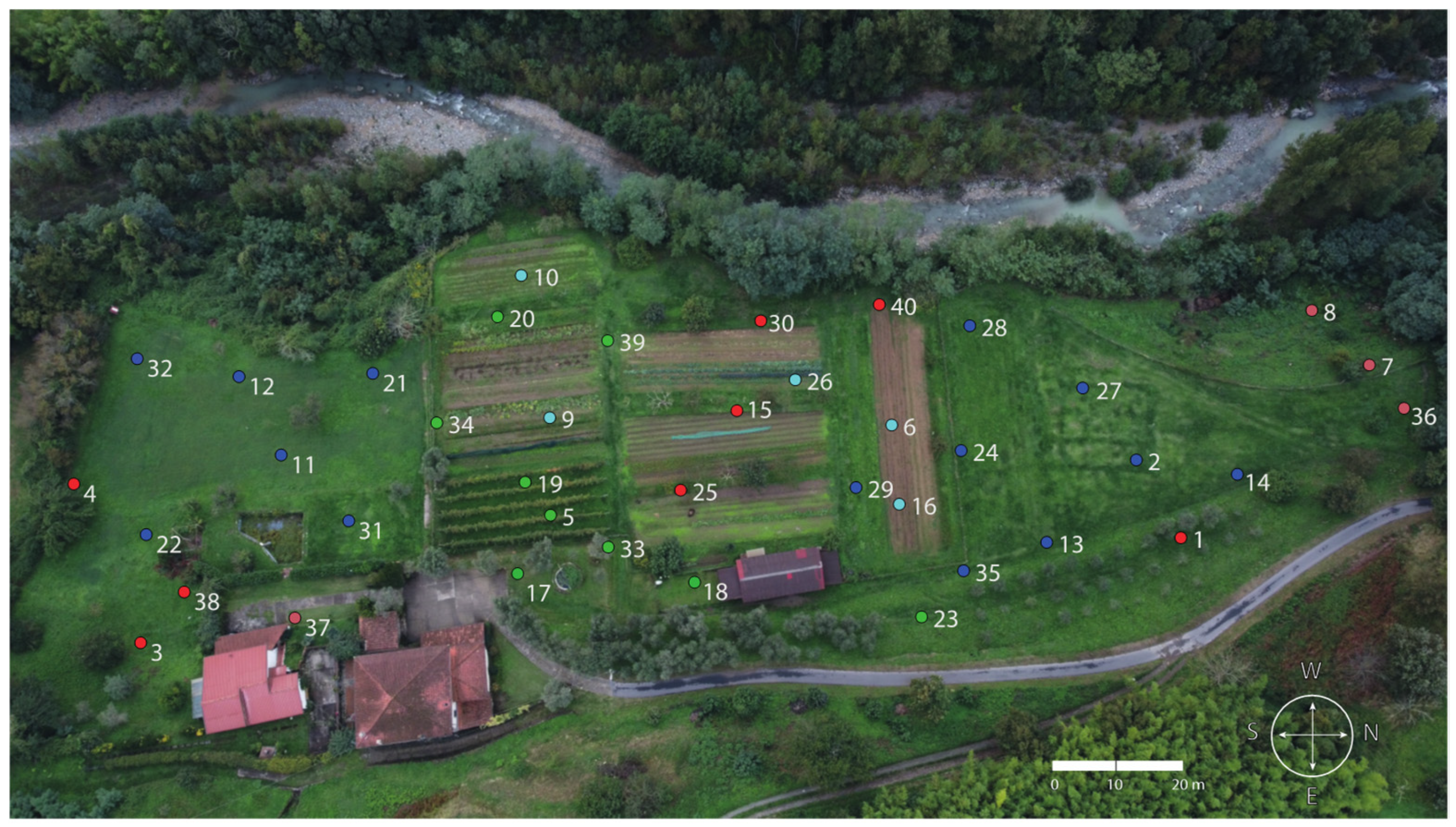
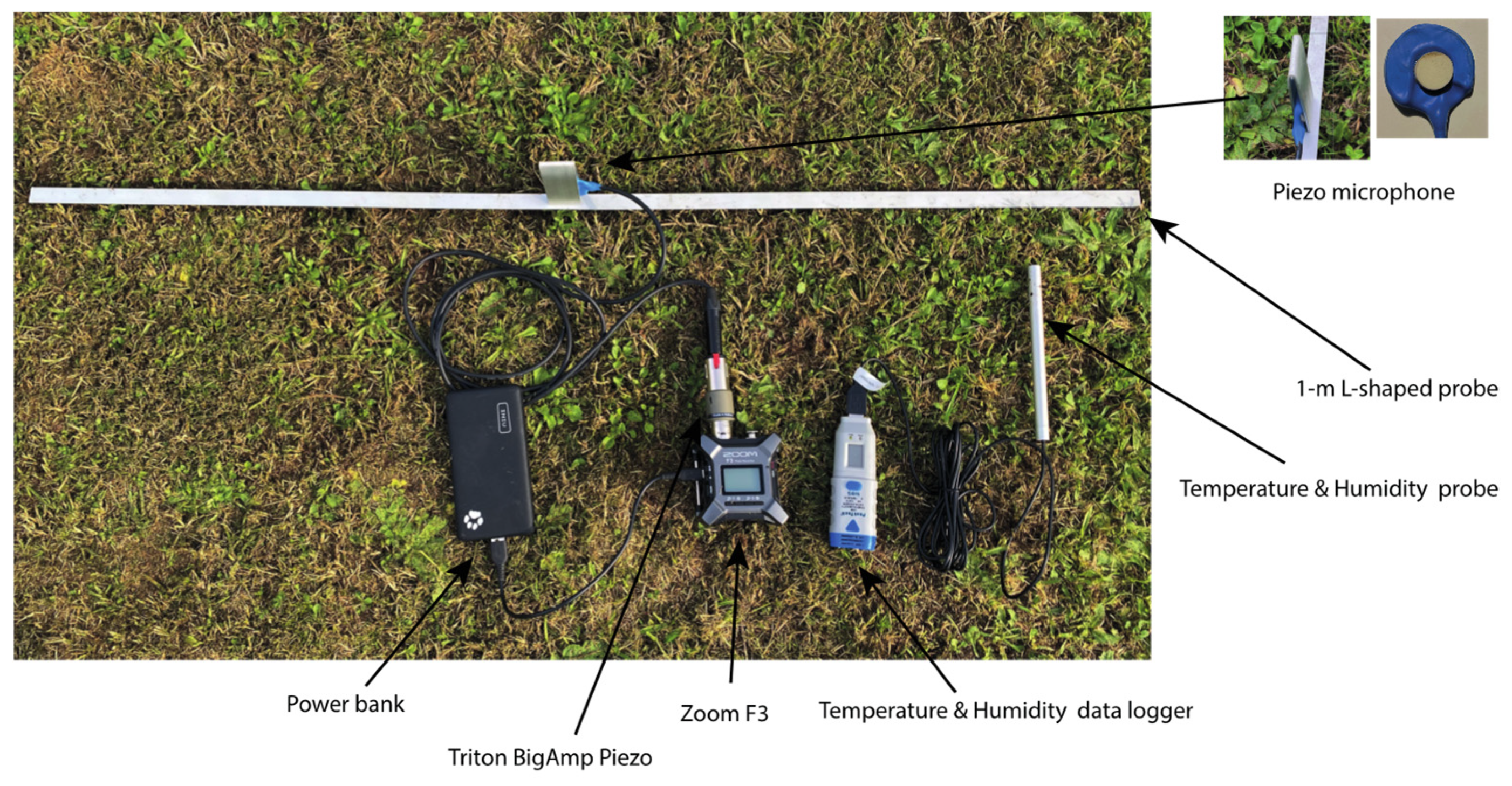
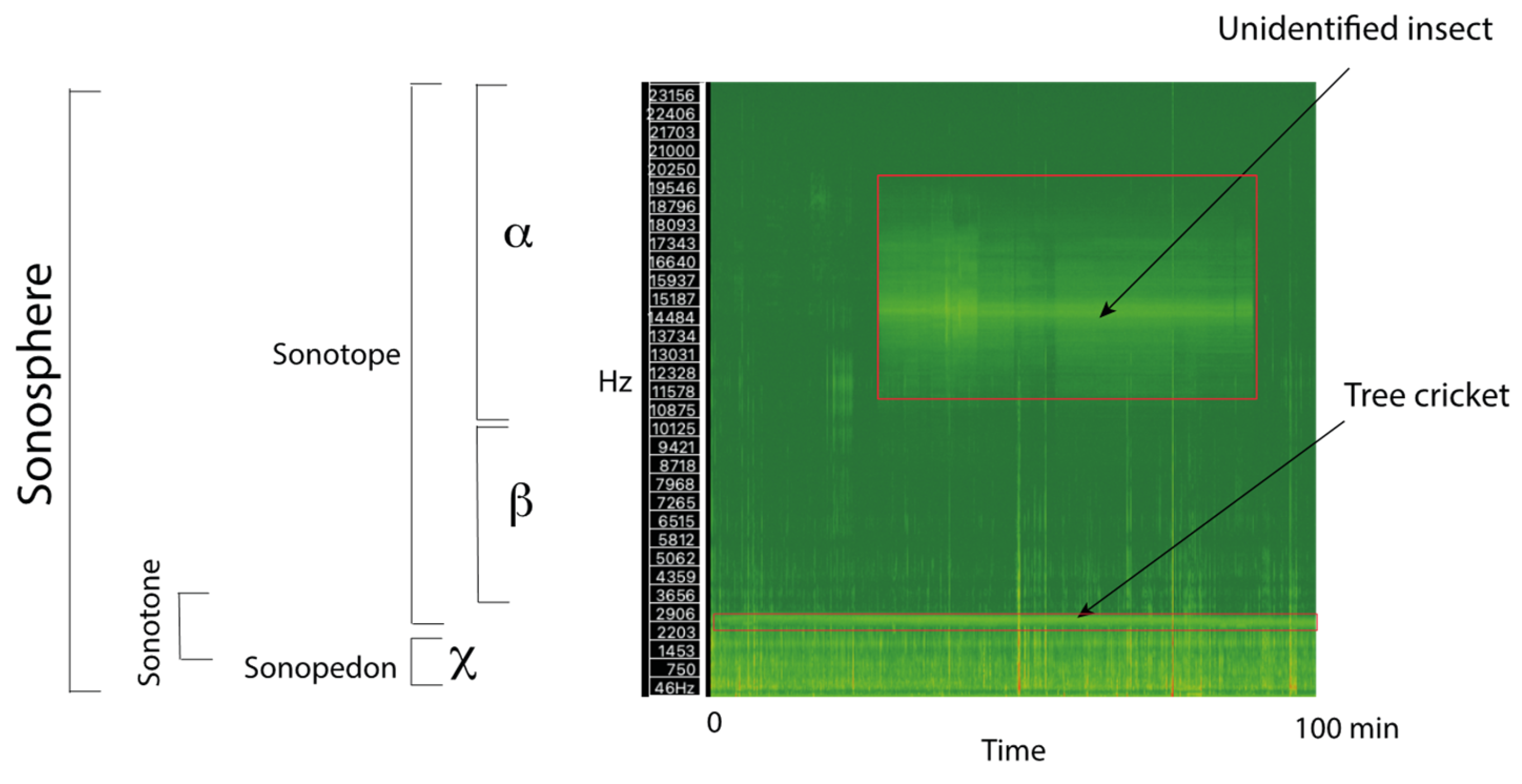



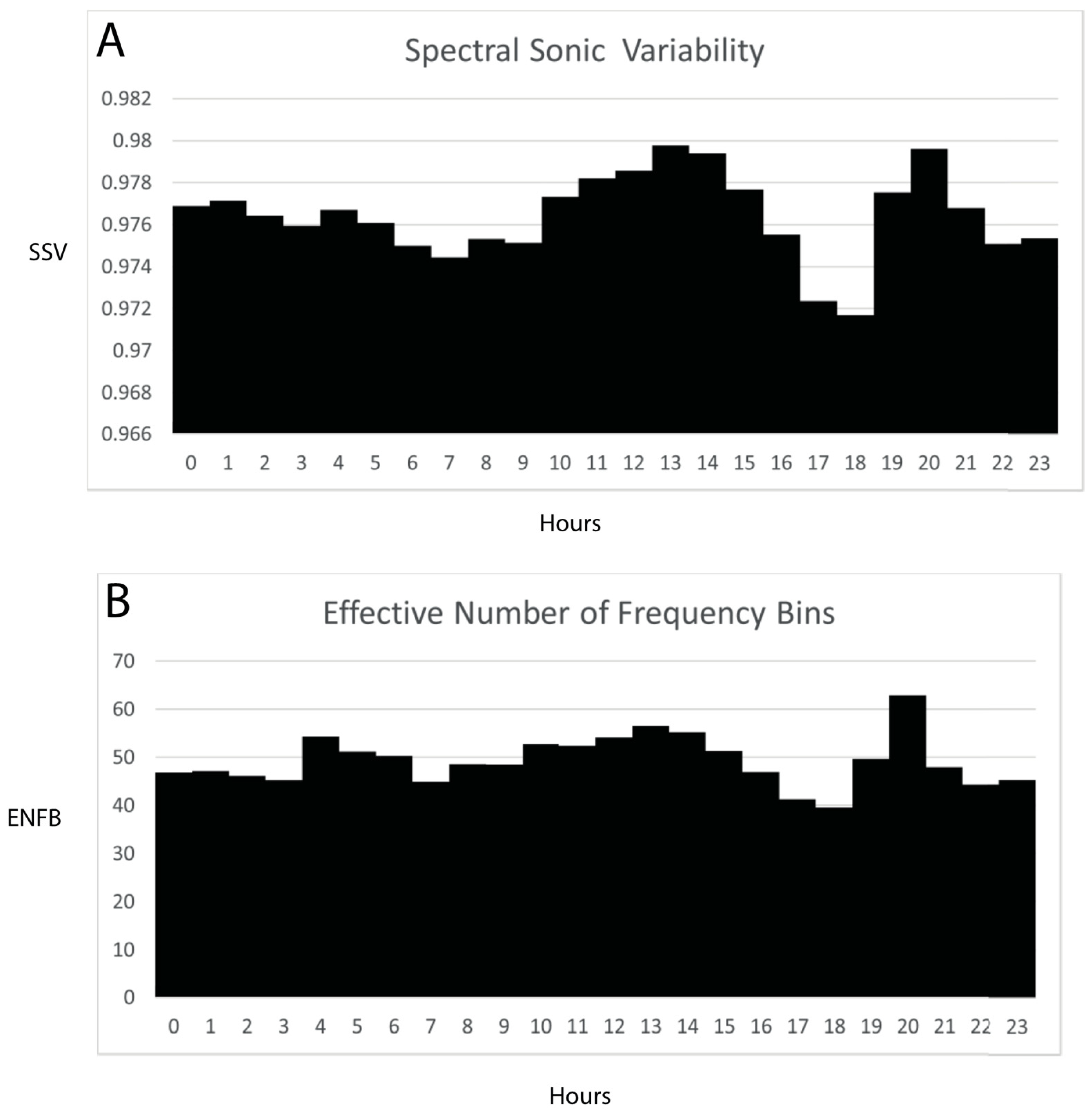
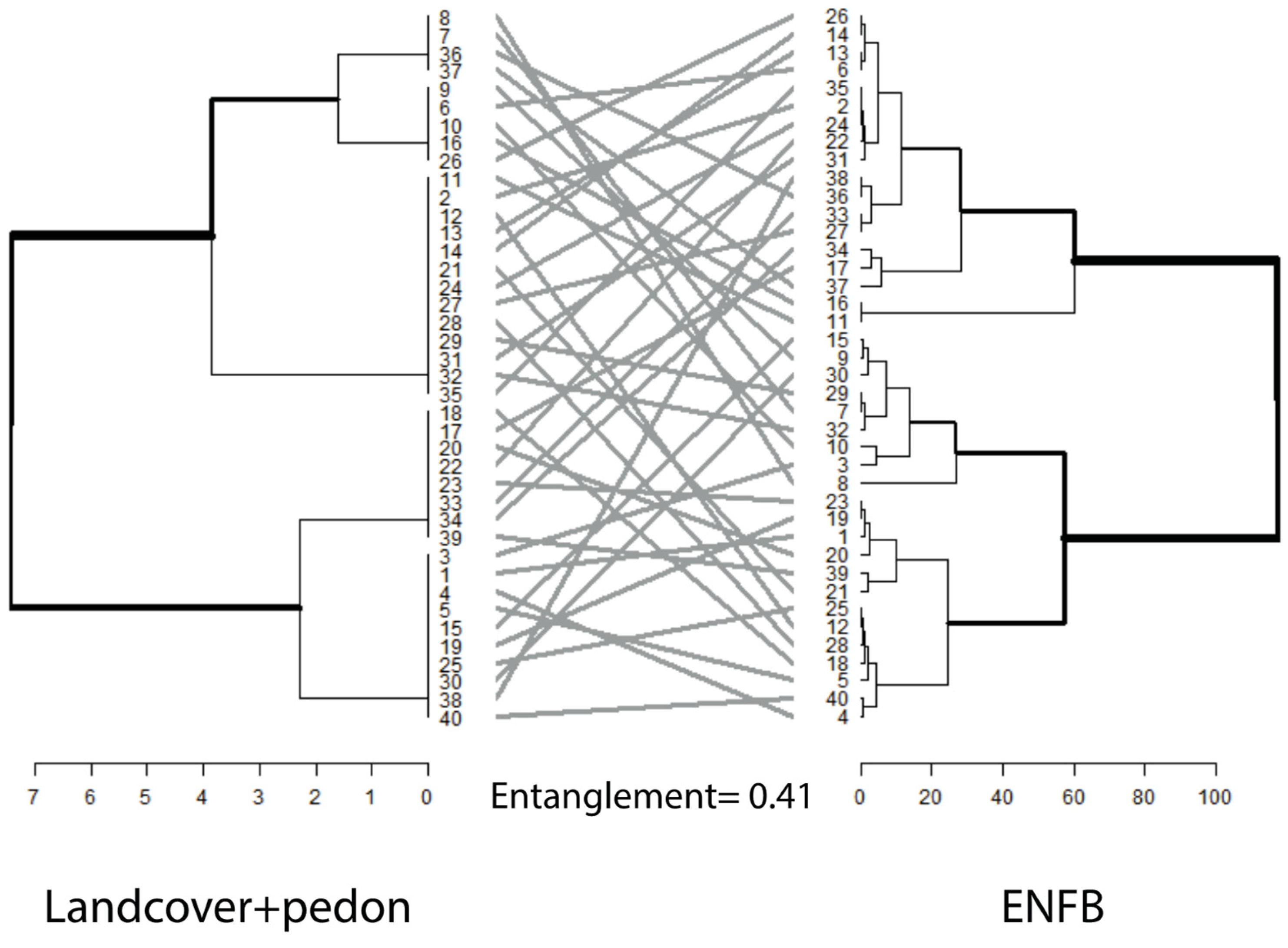
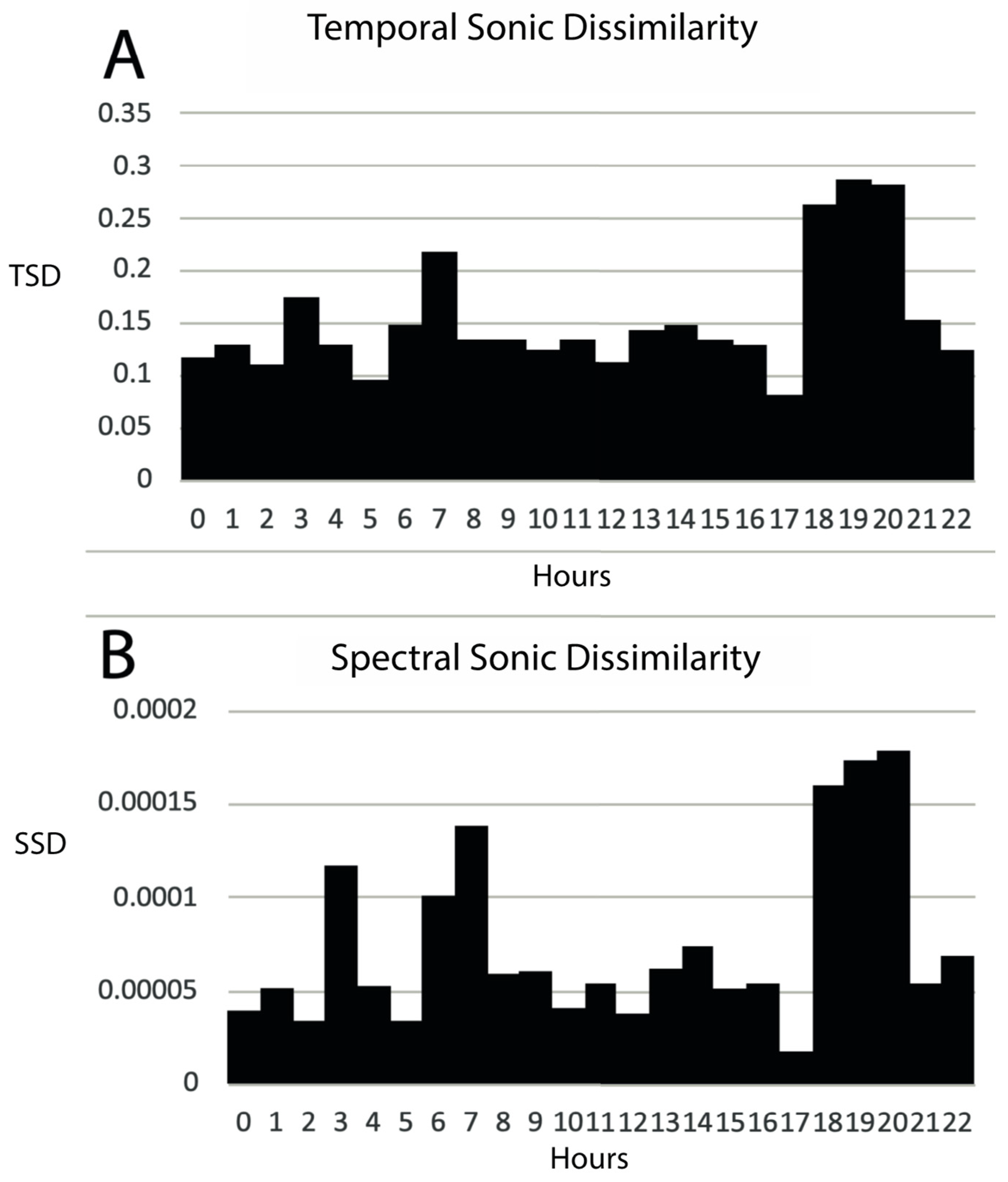
Disclaimer/Publisher’s Note: The statements, opinions and data contained in all publications are solely those of the individual author(s) and contributor(s) and not of MDPI and/or the editor(s). MDPI and/or the editor(s) disclaim responsibility for any injury to people or property resulting from any ideas, methods, instructions or products referred to in the content. |
© 2025 by the authors. Licensee MDPI, Basel, Switzerland. This article is an open access article distributed under the terms and conditions of the Creative Commons Attribution (CC BY) license (https://creativecommons.org/licenses/by/4.0/).
Share and Cite
Farina, A.; Mullet, T.C. Composition and Dynamics of the Sonosphere Along a Soil-Surface Ecotone at an Agricultural Site in Northern Italy: A Preliminary Approach. Geosciences 2025, 15, 34. https://doi.org/10.3390/geosciences15020034
Farina A, Mullet TC. Composition and Dynamics of the Sonosphere Along a Soil-Surface Ecotone at an Agricultural Site in Northern Italy: A Preliminary Approach. Geosciences. 2025; 15(2):34. https://doi.org/10.3390/geosciences15020034
Chicago/Turabian StyleFarina, Almo, and Timothy C. Mullet. 2025. "Composition and Dynamics of the Sonosphere Along a Soil-Surface Ecotone at an Agricultural Site in Northern Italy: A Preliminary Approach" Geosciences 15, no. 2: 34. https://doi.org/10.3390/geosciences15020034
APA StyleFarina, A., & Mullet, T. C. (2025). Composition and Dynamics of the Sonosphere Along a Soil-Surface Ecotone at an Agricultural Site in Northern Italy: A Preliminary Approach. Geosciences, 15(2), 34. https://doi.org/10.3390/geosciences15020034





